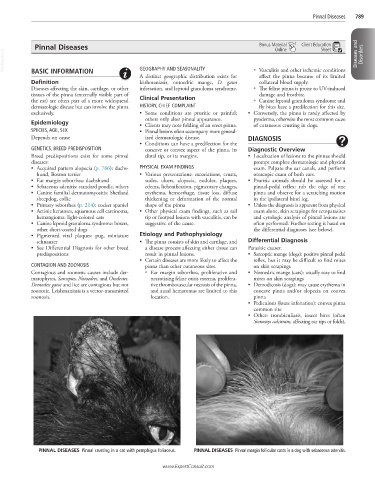Page 1567 - Cote clinical veterinary advisor dogs and cats 4th
P. 1567
Pinnal Diseases 789
Pinnal Diseases Bonus Material Client Education
Online
Sheet
VetBooks.ir Diseases and Disorders
GEOGRAPHY AND SEASONALITY
BASIC INFORMATION
affect the pinna because of its limited
A distinct geographic distribution exists for ○ Vasculitis and other ischemic conditions
Definition leishmaniasis, notoedric mange, D. gatoi collateral blood supply.
Diseases affecting the skin, cartilage, or other infestation, and leproid granuloma syndrome. ○ The feline pinna is prone to UV-induced
tissues of the pinna (externally visible part of Clinical Presentation damage and frostbite.
the ear) are often part of a more widespread ○ Canine leproid granuloma syndrome and
dermatologic disease but can involve the pinna HISTORY, CHIEF COMPLAINT fly bites have a predilection for this site.
exclusively. • Some conditions are pruritic or painful; • Conversely, the pinna is rarely affected by
others only alter pinnal appearance. pyoderma, otherwise the most common cause
Epidemiology • Clients may note folding of an erect pinna. of cutaneous crusting in dogs.
SPECIES, AGE, SEX • Pinnal lesions often accompany more general-
Depends on cause ized dermatologic disease. DIAGNOSIS
• Conditions can have a predilection for the
GENETICS, BREED PREDISPOSITION concave or convex aspect of the pinna, its Diagnostic Overview
Breed predispositions exist for some pinnal distal tip, or its margins. • Localization of lesions to the pinnae should
diseases: prompt complete dermatologic and physical
• Acquired pattern alopecia (p. 766): dachs- PHYSICAL EXAM FINDINGS exam. Palpate the ear canals, and perform
hund, Boston terrier • Various presentations: excoriations, crusts, otoscopic exam of both ears.
• Ear margin seborrhea: dachshund scales, ulcers, alopecia, nodules, plaques, • Pruritic animals should be assessed for a
• Sebaceous adenitis: standard poodle, others edema, lichenification, pigmentary changes, pinnal-pedal reflex: rub the edge of one
• Canine familial dermatomyositis: Shetland erythema, hemorrhage, tissue loss, diffuse pinna and observe for a scratching motion
sheepdog, collie thickening or deformation of the normal in the ipsilateral hind leg.
• Primary seborrhea (p. 214): cocker spaniel shape of the pinna • Unless the diagnosis is apparent from physical
• Actinic keratoses, squamous cell carcinoma, • Other physical exam findings, such as tail exam alone, skin scrapings for ectoparasites
hemangioma: light-colored cats tip or footpad lesions with vasculitis, can be and cytologic analysis of pinnal lesions are
• Canine leproid granuloma syndrome: boxers, suggestive of the cause. often performed. Further testing is based on
other short-coated dogs the differential diagnoses (see below).
• Pigmented viral plaques: pug, miniature Etiology and Pathophysiology
schnauzer • The pinna consists of skin and cartilage, and Differential Diagnosis
• See Differential Diagnosis for other breed a disease process affecting either tissue can Parasitic causes:
predispositions result in pinnal lesions. • Sarcoptic mange (dogs): positive pinnal pedal
• Certain diseases are more likely to affect the reflex, but it may be difficult to find mites
CONTAGION AND ZOONOSIS pinna than other cutaneous sites. on skin scrapings
Contagious and zoonotic causes include der- ○ Ear margin seborrhea, proliferative and • Notoedric mange (cats): usually easy to find
matophytes, Sarcoptes, Notoedres, and Otodectes. necrotizing feline otitis externa, prolifera- mites on skin scrapings
Demodex gatoi and lice are contagious but not tive thrombovascular necrosis of the pinna, • Demodicosis (dogs): may cause erythema in
zoonotic. Leishmaniasis is a vector-transmitted and aural hematomas are limited to this concave pinna and/or alopecia on convex
zoonosis. location. pinna
• Pediculosis (louse infestation): convex pinna
common site
• Other: trombiculiasis, insect bites (often
Stomoxys calcitrans, affecting ear tips or folds),
PINNAL DISEASES Pinnal crusting in a cat with pemphigus foliaceus. PINNAL DISEASES Pinnal margin follicular casts in a dog with sebaceous adenitis.
www.ExpertConsult.com

